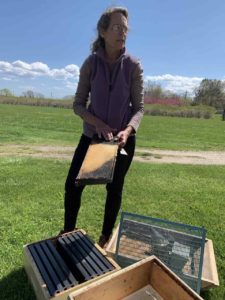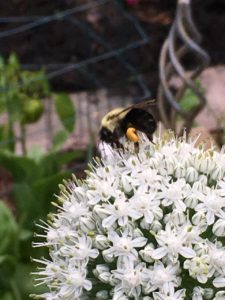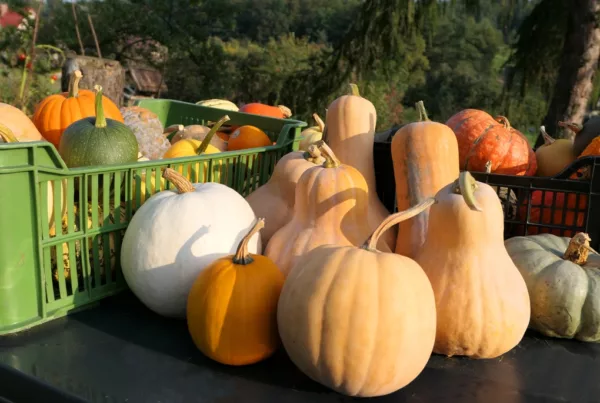Written by Laura Bartholomew
“The hum of bees is the voice of the garden.” – Elizabeth Lawrence
Talk about essential workers – did you know that bees and other pollinators are responsible for one third of the food we eat? Bees have many lessons to teach us about collaboration, biodiversity and survival, so my husband Steve – President of SFGF – and I traveled to Cutchogue, Long Island to spend a day at wholesale flower and honey producer Salt Air Farm, learning from owner Prudence Heston.
Prudence and her husband Dan run one of the country’s oldest farms, as the Salt Air land has been in the family since the late 1600s.

Prudence Heston, Salt Air Farm
Steve and I got an incredible education about bees and pollinators during our day on the farm, and that’s why this is Part 1 of our Salt Air Farm field trip blog. Today I’m focusing on the types of bees. In a few weeks I’ll share Part 2: how you can help pollinators thrive in your own garden.
“Bee” In the Know…Wasp or Bee?
As children we may have been a bit frightened by bees, but “there’s no such thing as a bad bee,” Prudence explained, and she includes wasps in that category.
Take a closer look the next time you notice a bee. Does it have a smooth, shiny body or does it have fuzz? That shiny, smooth body indicates a wasp, not a bee. Yellowjackets – striped but smooth – fall in the wasp category. Wasps are aggressive but they have a special job: they are nature’s “cleaner-uppers.” Known to be meat eaters, they help clean up roadkill once it’s been picked over. More importantly, they help control crop-eating pests in your garden and are “accidental” pollinators. Although humans consider yellow jackets and wasps a foe, they are food to our winged friends, birds.
Bees, on the other hand, are fuzzy and are basically harmless unless threatened. There are two main types of bees that Salt Air Farm attracts: bumble bees and honey bees. Here’s the difference:
Bumble bees pollinate vegetables and fruits. They move slowly from flower to flower, entering it to knock the pollen around (or “bumble it”) which helps self-pollinating plants such as tomatoes, peas, sunflowers, potatoes and many grains. As pollen collector, a bumble bee will store powdery pollen in sacks – called baskets – on its legs.
Honeybees, also pollinators, are thinner than the bumble bee, and with less “fuzz.” Often mistaken for wasps, people resort to sprays and professional extermination services without knowing how important these bees are. This sad reality threatens their very existence, especially when done on a large scale.
 Collecting nectar is the other job of honeybees, key to making honey. They move quickly from flower to flower of different plant species, cross pollinating plants which I learned is essential to crop survival. I didn’t know that apples, plums, pears, berries, squash, brassicas, eggplant, cucumber, lettuce and most flowering plants depend on cross pollination from bees as well as birds – and even the wind.
Collecting nectar is the other job of honeybees, key to making honey. They move quickly from flower to flower of different plant species, cross pollinating plants which I learned is essential to crop survival. I didn’t know that apples, plums, pears, berries, squash, brassicas, eggplant, cucumber, lettuce and most flowering plants depend on cross pollination from bees as well as birds – and even the wind.
For those interested in beekeeping and honey production, Prudence suggested the children’s book “The Life and Times of the Honeybee” by Charles Micucci. From there, Prudence advised contacting a beekeeping association, finding a class and working with an experienced beekeeper for at least a year before starting your own hive. Steve and I saw first-hand that beekeeping takes a lot of work and learning before you set out on your own!
When honeybees collect nectar and pollen, it is used as a food source for their energy and for the hive. Nectar is lapped up with the honeybees’ tongue, then stored in their stomachs. This nectar will become a form of diluted honey. They also collect sap used to varnish and seal cracks in the hive and for food.
There’s an ongoing pandemic when it comes to bees and their ultimate survival. So, let’s stop swatting, eradicating, or ignoring these superheroes of the food chain. We need to educate ourselves about their amazing contributions and how to protect these essential friends of the planet. Don’t worry, I’ve got you covered: stay tuned for my “bee tips” in Part Two of our Salt Air Farm blog!
Special thanks to Prudence Heston for sharing so much knowledge and time with us at the lovely Salt Air Farm, Cutchogue, NY. You can check them out here: https://www.saltairfarm.com/



